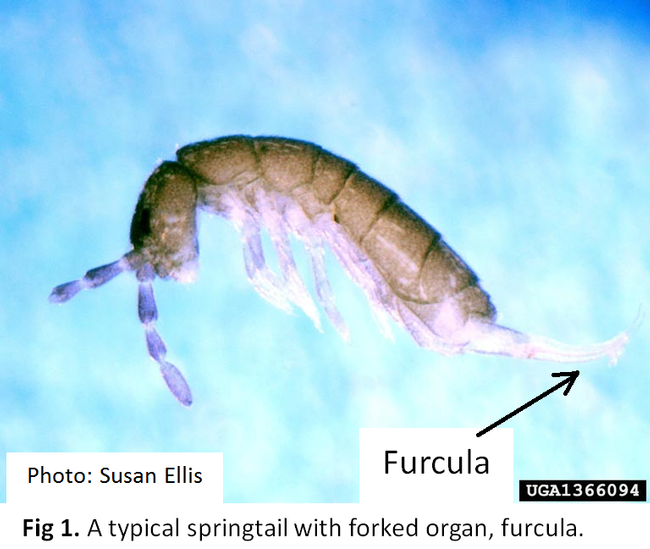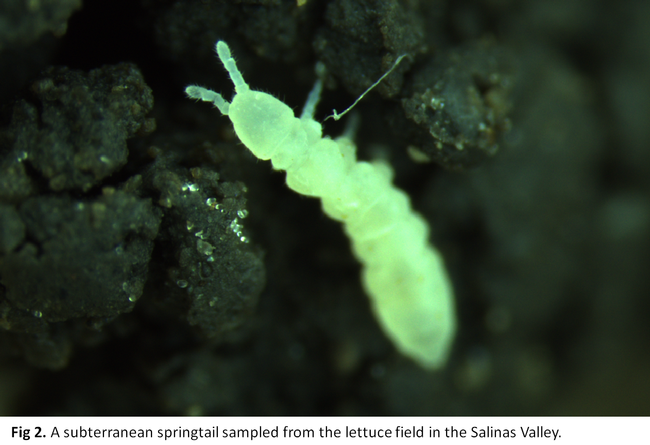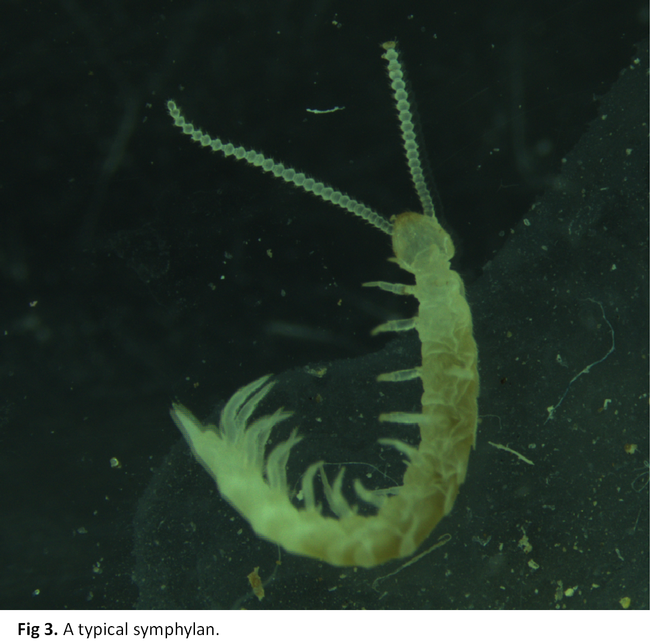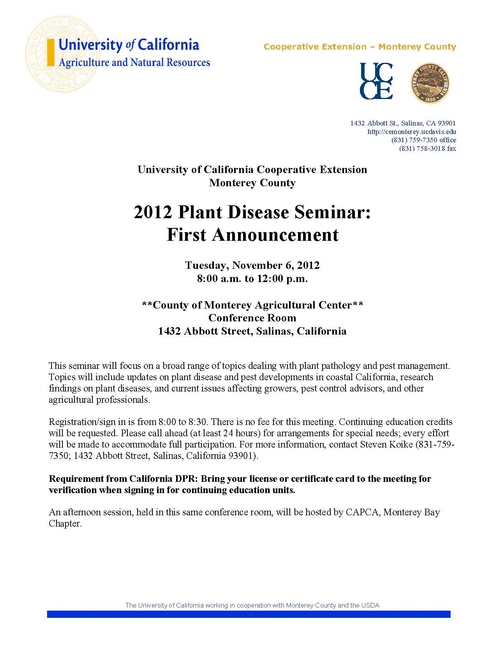- Author: Steven T. Koike
- Author: Carolee Bull
Chronic problem. Bacterial leaf spot of lettuce has been affecting coastal California crops for many years and has become a chronic problem. The disease was first noted in California in 1964 and became an economic concern in the 1990s. Bacterial leaf spot now occurs to some degree every season. In addition, it is possible that new strains of the pathogen may cause disease in previously resistant lettuce cultivars. For these reasons researchers are continuing to study the problem and are now requesting samples from cases that occur in 2013.
Symptoms. Early symptoms of bacterial leaf spot are small (1/8 to 1/4 inch), water-soaked spots that usually occur only on the older, outer leaves of the plant. Lesions are typically angular in shape because the pathogen does not penetrate or cross the veins in the leaf. Lesions quickly turn black—this is the diagnostic feature of this disease. If disease is severe, numerous lesions may coalesce, resulting in the collapse of the leaf. Older lesions dry up and become papery in texture, but retain the black color. Lesions rarely occur on newly developing leaves. If disease is severe, secondary decay organisms (bacteria, Botrytis cinerea) can colonize the leaves and result in a messy soft rot of the plant. Bacterial leaf spot can occur on all types of lettuce: iceberg, romaine, leaf, and butterhead. See photos below.
Pathogen. Bacterial leaf spot is caused by Xanthomonas campestris pv. vitians. The taxonomy of this pathogen is unsettled and the name is likely to change in the next few years. This bacterium is a pathogen mostly limited to lettuce, though under greenhouse conditions several weeds in the same plant family can develop bacterial leaf spot disease when inoculated. We have not yet found naturally infected weeds showing leaf spot symptoms in the field. Some researchers indicate that X. campestris pv. vitians from lettuce can infect very different crops such as pepper and tomato when these plants are artificially inoculated; however, naturally infected pepper and tomato have never been found in California. Bacterial leaf spot disease of lettuce should not be confused with other Xanthomonas diseases. For example, bacterial spot disease of tomato and pepper is caused by a distinct pathovar (Xanthomonas campestris pv. vesicatoria); this pathogen will not infect lettuce. However, a related pathogen caused bacterial leaf spot on radicchio in California.
Disease cycle. The pathogen is highly dependent on wet, cool conditions for infection and disease development. Splashing water from overhead irrigation and rain disperses the pathogen in the field and enables the pathogen to infect significant numbers of plants. The pathogen can be seedborne, though the extent and frequency of seedborne inoculum is not currently known. If lettuce transplants are grown from infested seed, the pathogen may become established on plants during the greenhouse phase of growth. The bacterium can survive for up to five months in the soil. Therefore, infected lettuce plants and residues, once disked into the soil, can supply bacterial inoculum that can infect a subsequent lettuce planting. The bacterium has also been found surviving epiphytically on weed plants, though the significance of this factor is not known. In terms of time of year, a very consistent pattern of bacterial leaf spot outbreaks is documented for the Salinas Valley. There is almost an annual pattern in which severe bacterial leaf spot occurs in August and September. Researchers have not clearly documented why the disease consistently occurs at severe levels in this late summer period.
Control. Clearly the elimination or reduction of the use of overhead sprinkler irrigation will significantly curtail this disease in all situations, except when rains occur. Some resistant lettuce lines have been identified, though resistance is not widely available in currently used cultivars. Residual bacterial inoculum, left in the soil following an infected lettuce crop, will potentially cause problems for the next lettuce planting unless that planting is delayed for five months or longer. Therefore, crop rotation schemes will need to be evaluated if bacterial leaf spot is a chronic problem in fields heavily planted to lettuce. Effective foliar sprays have not been identified for this disease. Lettuce seed should be free of the pathogen.
Samples needed. Differences in pathogen genotypes have been demonstrated and correlated to disease responses on resistant and susceptible lettuce cultivars. In California the deployed lettuce germplasm is resistant to the strains of the pathogen collected many years ago in California. We therefore request samples of bacterial leaf spot disease so as to determine if novel, resistance-breaking strains are found in California. If you encounter this disease, samples can be submitted to the Cooperative Extension Diagnostic Lab in Salinas (1432 Abbott Street, Salinas).



- Author: Shimat Villanassery Joseph

Springtails are generally considered as beneficial insects because they aid in the decomposition of the soil organic matter by feeding, which in turn improves soil health or structure. In addition, these insects feed on the soil dwelling fungal hyphae and spores. In the Salinas Valley, the cool weather in the spring slows the seed germination and decomposition of plant residues incorporated in the previous season (December). 
It is likely that these white springtails are easily mis-identified as symphylans because of white color, tiny, and lack the ability to jump. Symphylans are NOT insects but centipede-like organisms. Unlike symphylans, which move into deeper profiles of the soil, springtails remain active in the top layer of the soil, provided sufficient moisture is present. Springtail population crashes once the top soil layer does not have sufficient moisture because they hardly move to lower depths of the soil profile. Symphyans are also white in color, but are highly mobile; possess 10-12 pairs of legs, and multi-segmented antennae (Fig. 3).

- Author: Steven T. Koike
Coastal California growers, pest control advisors, and other field professionals might be on the alert for early outbreaks of lettuce problems caused by viruses. In particular, early confirmations have been made of the Tomato Spotted Wilt Virus (TSWV) on lettuce in this region. Affected leaves have tan, brown, or blackish spots and dead areas; this necrotic tissue can resemble damage caused by pesticide or fertilizer applications (see photos below). Some leaf yellowing can also be observed. If disease is advanced, symptoms can also be found on the newer leaves near the center of the plant axis. If plants are affected early in their development, growth can be stunted. Symptoms caused by TSWV in lettuce are indistinguishable from symptoms caused by the closely related Impatiens necrotic spot virus (INSV) which in some seasons can be commonly found on lettuce in the Salinas Valley. All lettuce types (iceberg, romaine, greenleaf, redleaf, butter) are susceptible to both TSWV and INSV. Both viruses are spread by thrips, are found in hundreds of crop and weed species, and are not seedborne. In our coastal region, TSWV and INSV are spread only by the western flower thrips (Frankliniella occidentalis).
Our laboratory has confirmed TSWV on lettuce in late March, which is rather early for such developments. PCAs also report early buildups of thrips populations in lettuce and other fields. The relatively dry spring is resulting in early drying up and senescing of weeds and hillside vegetation; this early decline of surrounding vegetation very likely is driving thrips populations into fields earlier than normal. Lettuce growers should be aware of possible early problems due to thrips vectoring tospoviruses into their fields.
Lettuce with tospovirus-like symptoms can be sent for analysis to the UC Cooperative Extension diagnostic laboratory in Salinas.
Tomato spotted wilt on lettuce.
Tomato spotted wilt on lettuce.
Impatiens necrotic spot on lettuce
Impatiens necrotic spot on lettuce
- Author: Steven T. Koike
2012 Pl Dis Sem annouce
- Author: Steven T. Koike
2012PlDisSemFirstNew







